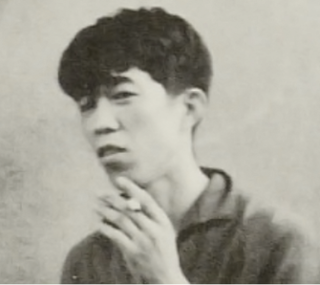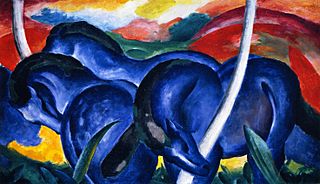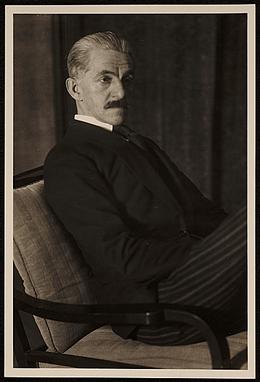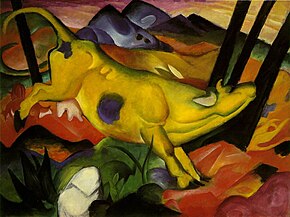
Wassily Wassilyevich Kandinsky was a Russian painter and art theorist. Kandinsky is generally credited as one of the pioneers of abstraction in western art. Born in Moscow, he spent his childhood in Odessa, where he graduated from Odessa Art School. He enrolled at the University of Moscow, studying law and economics. Successful in his profession, he was offered a professorship at the University of Dorpat. Kandinsky began painting studies at the age of 30.

Max Ernst was a German painter, sculptor, printmaker, graphic artist, and poet. A prolific artist, Ernst was a primary pioneer of the Dada movement and Surrealism in Europe. He had no formal artistic training, but his experimental attitude toward the making of art resulted in his invention of frottage—a technique that uses pencil rubbings of textured objects and relief surfaces to create images—and grattage, an analogous technique in which paint is scraped across canvas to reveal the imprints of the objects placed beneath. Ernst is noted for his unconventional drawing methods as well as for creating novels and pamphlets using the method of collages. He served as a soldier for four years during World War I, and this experience left him shocked, traumatised and critical of the modern world. During World War II he was designated an "undesirable foreigner" while living in France.

The Solomon R. Guggenheim Foundation is a nonprofit organization founded in 1937 by philanthropist Solomon R. Guggenheim and his long-time art advisor, artist Hilla von Rebay. The foundation is a leading institution for the collection, preservation, and research of modern and contemporary art and operates several museums around the world. The first museum established by the foundation was The Museum of Non-Objective Painting, in New York City. This became The Solomon R. Guggenheim Museum in 1952, and the foundation moved the collection into its first permanent museum building, in New York City, in 1959. The foundation next opened the Peggy Guggenheim Collection in Venice, Italy, in 1980. Its international network of museums expanded in 1997 to include the Guggenheim Museum Bilbao in Bilbao, Spain, and it expects to open a new museum, Guggenheim Abu Dhabi, in the United Arab Emirates after its construction is completed.

Franz Moritz Wilhelm Marc was a German painter and printmaker, one of the key figures of German Expressionism. He was a founding member of Der Blaue Reiter, a journal whose name later became synonymous with the circle of artists collaborating in it.

Robert Delaunay was a French artist of the School of Paris movement; who, with his wife Sonia Delaunay and others, co-founded the Orphism art movement, noted for its use of strong colours and geometric shapes. His later works were more abstract. His key influence related to bold use of colour and a clear love of experimentation with both depth and tone.

On Kawara was a Japanese conceptual artist who lived in SoHo, New York City, from 1965. He took part in many solo and group exhibitions, including the Venice Biennale in 1976.

Hildegard Anna Augusta Elisabeth FreiinRebay von Ehrenwiesen, known as Baroness Hilla von Rebay or simply Hilla Rebay, was an abstract artist in the early 20th century and co-founder and first director of the Solomon R. Guggenheim Museum. She was a key figure in advising Solomon R. Guggenheim to collect abstract art, a collection that would later form the basis of the Solomon R. Guggenheim Museum collection. She was also influential in selecting Frank Lloyd Wright to design the current Guggenheim museum, which is now known as a modernist icon in New York City.

Solomon Robert Guggenheim was an American businessman and art collector. He is best known for establishing the Solomon R. Guggenheim Foundation and the Solomon R. Guggenheim Museum in New York City.

Blue Horses or Die grossen blauen Pferde is a 1911 painting by German painter and printmaker Franz Marc (1880–1916).

Alexander Georg Rudolf Bauer was a German-born painter who was involved in the avant-garde group Der Sturm in Berlin, and whose work would become central to the non-objective art collection of Solomon R. Guggenheim.
Alfred Julio Jensen was an abstract painter. His paintings are often characterized by grids of brightly colored triangles, circles or squares, painted in thick impasto. Conveying a complex web of ideas, often incorporating calligraphy or numerical systems, they are frequently referred to as "concrete" abstract art. After his death in 1981, the Guggenheim organized a major retrospective of his work, having held his solo exhibition there in 1961.

Sidney Jonas Budnick was an American abstract artist. He was born and raised in New York City.

Rudolf Koller was a Swiss painter. He is associated with a realist and classicist style, and also with the essentially romantic Düsseldorf school of painting. Koller's style is similar to that of the realist painters Gustave Courbet and Jean-Baptiste-Camille Corot. Considered Switzerland's finest animal painter, Koller is rated alongside George Stubbs, Rosa Bonheur and Théodore Géricault. While his reputation was based on his paintings of animals, he was a sensitive and innovative artist whose well-composed works in the "plein air" tradition, including Swiss mountain landscapes, are just as finely executed.

The Deutsche Guggenheim was an art museum in Berlin, Germany, open from 1997 to 2013. It was located in the ground floor of the Deutsche Bank building on the Unter den Linden boulevard.

Woman with a Fan is an oil painting created in 1912 by the French artist and theorist Jean Metzinger (1883–1956). The painting was exhibited at the Salon d'Automne, 1912, Paris, and De Moderne Kunstkring, 1912, Amsterdam. It was also exhibited at the Musée Rath, Geneva, Exposition de cubistes français et d'un groupe d'artistes indépendants, 3–15 June 1913. A 1912 photograph of Femme à l'Éventail hanging on a wall inside the Salon Bourgeois was published in The Sun, 10 November 1912. The same photograph was reproduced in The Literary Digest, 30 November 1912.

Fate of the Animals is a painting by Franz Marc created in 1913. It is oil on canvas. This work contrasts most of Marc's other works by presenting animals in a brutal way rather than depicting them in a peaceful manner. Marc's strong ties with animals as his subjects remains uncertain, but it is predicted to stem from his childhood dog. Fate of the Animals remains one of Marc's most famous pieces and displays Der Blaue Reiter style that he co-founded with Wassily Kandinsky. The painting currently resides in the Kunstmuseum in Basel, Switzerland.
Woman Ironing is a 1904 oil painting by Pablo Picasso that was completed during the artist's Blue Period (1901—1904). This evocative image, painted in neutral tones of blue and gray, depicts an emaciated woman with hollowed eyes, sunken cheeks, and bent form, as she presses down on an iron with all her will. A recurrent subject matter for Picasso during this time is the desolation of social outsiders. This painting, as the rest of his works of the Blue Period, is inspired by his life in Spain but was painted in Paris.

Woman with Parakeet is a painting by Pierre-Auguste Renoir created in 1871. It is in the holdings of the Solomon R. Guggenheim Museum in New York as part of the Thannhauser Collection. The painting portrays model Lise Tréhot, who posed for Renoir in over twenty paintings during the years 1866 to 1872.
Green Violinist is a 1923–24 painting by artist Marc Chagall that is now in the permanent collection of the Solomon R. Guggenheim Museum in New York City. The work depicts a fiddler as the central figure who appears to be floating or dancing above the much smaller rooftops of the misty gray village below. This work is often considered to be the inspiration for the title of the 1964 musical Fiddler on the Roof.

Horses in Landscape is a watercolour with pencil on paper by the German painter Franz Marc, executed in 1911. It is probably a study, which was thought to be lost, for the painting Blue Horses (1911). The painting became known worldwide on the occasion of the Schwabing art discovery in November 2013. It was one of the first eleven works to be shown at a press conference by the Augsburg public prosecutor. The small-format work measures 12.1 × 19.6 cm.

















